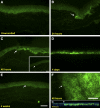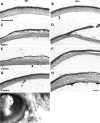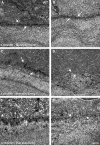αVβ6 integrin promotes corneal wound healing
- PMID: 21960555
- PMCID: PMC3208190
- DOI: 10.1167/iovs.11-8194
αVβ6 integrin promotes corneal wound healing
Abstract
Purpose: To appreciate the role of the integrin αvβ6 in corneal wound repair, corneal debridement and keratectomy in β6 knockout (β6(-/-)) mice were examined.
Methods: Either a 2-mm debridement or keratectomy was made in 129SVE wild type mice (WT) and β6(-/-) mice and allowed to heal for up to 4 months. The pattern of corneal restoration was studied "in vivo" by slit lamp and in tissue sections by means of both light and electron microscopy. In addition, αvβ6, α6β4, laminin, and fibronectin were evaluated by indirect immunofluorescence microscopy and/or Western blot analysis.
Results: αvβ6 expression was upregulated in migrating corneal epithelium after a keratectomy. Healing rates were unaffected in debridement wounds, but were significantly slowed in keratectomy wounds. Most dramatically, mice lacking αvβ6 had a severe defect in basement membrane zone (BMZ) regeneration. Levels of laminin were greatly reduced and no BMZ reformation was observed in transmission electron microscopy (TEM). In addition, hemidesmosome reformation was also impaired in the β6(-/-) mice. Analysis of the hemidesmosome component α6β4 indicated that normal amounts of this integrin were synthesized, suggesting that the defect was in reassembly of the hemidesmosomes. Finally, fibronectin persisted in the BMZ for as long as 4 months after keratectomy in the β6(-/-) mice.
Conclusions: It is hypothesized that the lack of αvβ6 leads to reduced laminin production during wound repair. This lack of laminin prevents reassembly of the BMZ and mature hemidesmosomes after keratectomy in β6(-/-) mice.
Figures








References
-
- Ruoslahti E, Pierschbacher MD. New perspectives in cell adhesion: RGD and integrins. Science. 1987;238:491–497 - PubMed
-
- Hynes RO. Integrins: a family of cell surface receptors. Cell. 1987;48:549–554 - PubMed
-
- Clark EA, Brugge JS. Integrins and signal transduction pathways: the road taken. Science. 1995;268:233–239 - PubMed
-
- Breuss JM, Gillett N, Lu L, Sheppard D, Pytela R. Restricted distribution of integrin beta 6 mRNA in primate epithelial tissues. J Histochem Cytochem. 1993;41:1521–1527 - PubMed
-
- Breuss JM, Gallo J, DeLisser HM, et al. Expression of the beta 6 integrin subunit in development, neoplasia and tissue repair suggests a role in epithelial remodeling. J Cell Sci. 1995;108:2241–2251 - PubMed
Publication types
MeSH terms
Substances
Grants and funding
LinkOut - more resources
Full Text Sources
Other Literature Sources
Medical
Molecular Biology Databases

